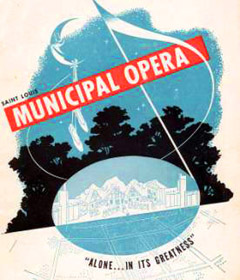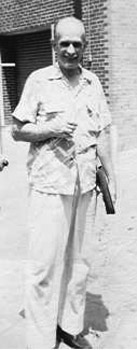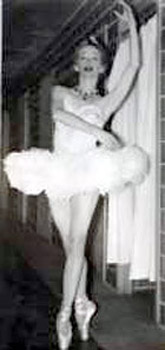|
CHAPTER 4 Meet Me In St. Louis, 1954 "The Muny", a 12,000 seat outdoor amphitheater featured Broadway musicals from mid-June through mid-August. It was and still is entrenched in the entertainment fabric of St. Louis and has gained international fame for the quality of its productions. It’s located in Forest Park where the nearby Art Museum is nearly all that remains of the famous World’s Fair of 1905. This fair serves as a background in the closing scene of the 1944 movie “Meet Me In St. Louis” starring Judy Garland. The Muny had a huge revolving stage the size of Radio City Music Hall and the scenery for the musicals were built right there on the lot, which usually surpassed even the original Broadway sets. In the pit was the St. Louis Symphony, conducted by Edwin McArthur, who had been the famed opera singer Kirsten Flagstad’s personal accompanist and biographer.
Photo: Anthony Nelle Joan and I spent our final night together in my tiny room on 12th Street in Greenwich Village and the next day I left for St. Louis with the other dancers on an overnight train. I was out of pocket of course and asked one of the other dancers if he could lend me some until our first pay-check. The generous lender of ten dollars was Mickey Callin, who was later to change his name to Michael Callan and become a movie star of some magnitude, after he was discovered in the original musical “West Side Story”. It must have been a particularly unusual crop of dancers that season as of us nine boys, several more would become famous. Larry Fuller became assistant to Michael Bennett who achieved world fame as the choreographer of “A Chorus Line” and other Broadway hits. Bennett later died in Tucson, Arizona, while Larry went on to become a choreographer himself with his most famous Broadway hit, “Evita”. Carl Jablonski was another who later went to Hollywood and choreographed Academy Award specials. Don Emmons became a dancing star in many musicals on Broadway. Richard Gain, then little more than a beginner and just out of high school, went on to become a principle with American Ballet Theater and with Martha Grahams’s company. As far as I know, none of the girls went very far.
We opened with “Call Me Madam” starring then little
known Elaine Stritch. Then “New Moon”, “Song Of Norway”, “Roberta”,
“Mikado”, “Gentlemen Prefer Blondes”, “Three Musketeers”, “Panama
Hattie”, “Where’s Charlie”, “Red Mill” and ending with “Oklahoma!”
in which I had a solo role as the rodeo cowboy on a wild bronco. I mentioned to Bowman that I had once danced with her at the Muny. Actually, I had only lifted her once and supported her in a pirouette during the big ballet sequence in “Song Of Norway”. I was just one of the undistinguishable ballet boys, but she graciously said she remembered me.
Photo: Prima Ballerina,
Patricia Bowman posing for me backstage at the Muny. Both boys and girls took turns being ‘swing person’, meaning that you had to learn the numbers but actually dance in them only as a replacement if someone was out. As the summer wore on and no one seemed to be missing a performance, we grew lax at learning routines that we were unlikely to perform anyway. That was a big mistake. During the week’s run of the musical “Roberta” I happened to be swing boy for its opening number, a Fred Astaire/Ginger Rogers type of routine. I hadn’t really bothered to learn it except for the opening moves. Fifteen minutes before curtain I was told I had to go on, and it was the dance number that opened the show. My partner and I, placed downstage front and center, began the dance. We boys were dressed in tuxedos with detachable cardboard shirt fronts, called dickeys. Behind us were the other dancers, following us. After the first few steps I was supposed to leave my original partner and go to different girls. “Where do I go to next” I would whisper to each girl while setting her down from a lift. She would whisper back ,“Go to Sally, then to Jane” and so on, while I frantically searched the stage for whoever was next. The huge audience began to laugh. “They’re laughing at me” I whispered to the last girl I danced with. Finally the dance was over. I’m going to be fired, I thought as I heroically walked off stage. Backstage, to my relief, Mr. Nelle said they were not actually laughing at me but at another boy dancer whose dickey had broken loose and rolled up in his face! From then on I made it a point to totally learn any number I was not to dance in, but that was the one and only time I ever had to do it.
It was a rough schedule; While we were performing
one show every evening, during the day we rehearsed
Photo: In “Oklahoma”
[backstage snapshot]
Photos: Above - First car, a DeSoto convertible. Right - First recital I truly missed New York, but I’d made a lot of new friends and kept telling myself as I drove my car around town, how much better off I was in St. Louis. In the end, after a year of teaching and staging my first student recital in which I also danced, I made another move. I wondered, as long as I enjoyed teaching - why not have my very own dancing school? I would have to shop for a location. Stuffing my car with possessions and saying goodbye to my friends I headed back East.
|
 In
May, an audition came up for the Municipal Opera in St. Louis. The
choreographer was Anthony Nelle.
In
May, an audition came up for the Municipal Opera in St. Louis. The
choreographer was Anthony Nelle. I was accepted along with four other boys and five
girls, each of us New Yorkers. The other five boy dancers and the
rest of the girls, seventeen in all, were to be from either St.
Louis itself or its surrounding areas. We were to leave for St.
Louis in a week or so.
I was accepted along with four other boys and five
girls, each of us New Yorkers. The other five boy dancers and the
rest of the girls, seventeen in all, were to be from either St.
Louis itself or its surrounding areas. We were to leave for St.
Louis in a week or so.
 Patricia
Bowman was the first American Prima Ballerina who opened the Roxy
Theater in New York in 1929. The great Leonide Massine was the house
choreographer then, producing extravagant production numbers, some
even including elephants, which received popular if not critical
acclaim. This was of course long before my humble job there as a
candy salesman in 1950.
Patricia
Bowman was the first American Prima Ballerina who opened the Roxy
Theater in New York in 1929. The great Leonide Massine was the house
choreographer then, producing extravagant production numbers, some
even including elephants, which received popular if not critical
acclaim. This was of course long before my humble job there as a
candy salesman in 1950.

 the
show for the following week. After the final performance on Sunday
evening there was the dress rehearsal for the next show, lasting
until dawn. Monday was the only free day, but then, when you are
young you have boundless energy.
the
show for the following week. After the final performance on Sunday
evening there was the dress rehearsal for the next show, lasting
until dawn. Monday was the only free day, but then, when you are
young you have boundless energy. Luckily,
one day I noticed an announcement placed on the backstage call
Luckily,
one day I noticed an announcement placed on the backstage call board from a local dancing school that was looking for a teacher. At
Summer’s end, the other dancers went their own ways and I began a
new life as a teacher and resident of St. Louis. I moved into a nice
apartment and bought a TV set and a little puppy, then my first car
– a DeSoto convertible.
board from a local dancing school that was looking for a teacher. At
Summer’s end, the other dancers went their own ways and I began a
new life as a teacher and resident of St. Louis. I moved into a nice
apartment and bought a TV set and a little puppy, then my first car
– a DeSoto convertible.